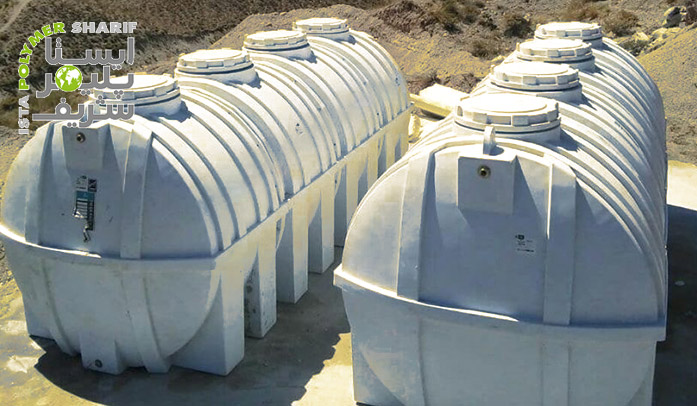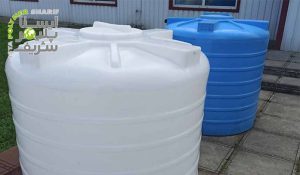Today, with the increase in population, urban density, as well as water scarcity and decreased pressure, many buildings utilize water storage tanks. These tanks come in various types and have distinct characteristics. Unlike in the past, tanks are not produced in very large dimensions with heavy weights; rather, they are suitable for storage in any space and are produced in a wide range of materials, dimensions, and appearances. Join us to become familiar with the types of food-grade water storage tanks and their advantages.
Food-Grade Water Storage Tank
Supplying the necessary water for residential, commercial, and administrative buildings in densely populated areas requires equipment, with one of the most important being the food-grade water storage tank. This tank, complying with health standards, preserves water for a long time and provides easier access to water for consumers. Generally, various types of food-grade tanks are used either in emergency situations or, accompanied by a pump, to assist in supplying water to buildings at higher elevations due to water pressure shortages. The diverse dimensions and appearances of food-grade water storage tanks allow customers to use this product in various environmental conditions without any placement restrictions. Additionally, manufacturers today produce tanks on a custom basis to meet the requirements of customers and fit the environmental conditions.
Types of Food-Grade Water Storage Tanks
As mentioned, food-grade water storage tanks are now considered essential equipment for buildings and have various applications. Therefore, to ensure that all consumers can use this product, its production is necessary in different types. Manufacturers of food-grade tanks have attempted to introduce this product to the market in various forms by identifying customer needs, as outlined below.
Types of Food-Grade Tanks in Terms of Appearance
To address environmental and height restrictions and to produce a tank suitable for environmental conditions, manufacturers have produced food-grade water storage tanks in various forms. Generally, tanks are produced in the following shapes:
-
- Horizontal
- Vertical
- Cylindrical
- Under stairs
- Cubical
Types of Food-Grade Tanks in Terms of Material
Water storage in different environmental conditions is a sensitive and challenging task, as the possibility of algae growth, sunlight exposure, and temperature changes can lead to water contamination. For this reason, different types of raw materials with different characteristics are used depending on the conditions so that customers can purchase a suitable tank according to their needs and the advantages of each material.
Food-Grade Steel Water Storage Tank
Two types of raw materials, ordinary steel and stainless steel, can be used to produce steel water tanks. Ordinary steel is not resistant to corrosion, but it can withstand corrosion by using special coatings. Additionally, the initial corrosion of galvanized steel creates a coating on the surface to prevent deeper corrosion. Nowadays, galvanized steel with a higher concentration is used in the production of food-grade water storage tanks, which slightly affects the taste of the water but does not compromise its health and safety. Stainless steel is another material that can be used to produce food-grade tanks. This material does not have the weaknesses of the previous example and contributes to the production of a hygienic tank.
Concrete Food-Grade Water Storage Tank
Concrete water tanks are another type of food-grade tank that has been used from the past to the present. These tanks are produced in small, medium, and large dimensions, with the majority of their current usage being underground. The heavy weight of these water tanks makes their storage difficult, and their installation is not easy and requires an experienced specialist. Typically, to control the weight of concrete food-grade water storage tanks, supporting bases are used to distribute the weight and prevent damage to the ground.
Polyethylene Food-Grade Water Storage Tank
Polyethylene, as a material resistant to rust and corrosion, leads to the production of suitable water tanks that meet sufficient standards. Important factors to consider when purchasing a food-grade water storage tank include weight, hygiene, resistance, and variety, all of which polyethylene tanks possess. Advanced manufacturers today use methods to produce algae-resistant tanks, making polyethylene tanks more popular than ever before. Additionally, these tanks come in different layers, and it is advisable to use tanks with more layers in direct sunlight conditions. Polyethylene food-grade water storage tanks have many advantages due to their extensive material properties, some of the most important of which include:
-
- Lightweight and easy to move
- Resistance to sunlight
- Prevention of algae growth
- Impact resistance
- Easy installation in various environmental conditions
- Extensive variety in appearance, dimensions, number of layers, and more
- Cost-effectiveness
Fiberglass Food-Grade Water Storage Tank
These tanks are made of reinforced plastic with glass fibers, making them very hard and sturdy. However, they are equally prone to cracking and breakage, which may lead to leakage. These food-grade water storage tanks allow more light to pass through, requiring the use of a black coating in the middle layer or coloring the outer part of the tank to contain it.
Remember that in all of these examples, the material of the inner layer is very important due to its direct contact with water. Therefore, ensure the quality and hygiene of that layer.
Choosing a Food-Grade Water Storage Tank
The diversity of food-grade tank options may confuse you when selecting and purchasing the tank you need. Therefore, in this section, we help you choose a food-grade water storage tank by providing some important tips.
It is best to calculate the location and dimensions of the tank based on the number of users, consult experts in this field, and then determine the suitable material and appearance.
Among the introduced tanks, polyethylene water storage tanks have a wide variety that allows you to use them in any situation. Additionally, their resistance to impact, corrosion, and rust creates a hygienic environment for water storage.
If you intend to place the tank on the rooftop, it is better to use a horizontal type to prevent it from falling during windy conditions and to maintain better balance.
In many homes, the area under the stairs is a suitable place for storing water tanks. In these situations, use under-stair or cubical tanks for easy fitting.
One of the challenges of installing a food-grade water storage tank is its inability to pass through narrow doors and corridors. In such cases, you can use easily portable tanks.
Finally, after selecting the dimensions, material, appearance, and other physical characteristics of the food-grade water storage tank, negotiate with reputable manufacturer sales consultants. Obtain information about the product, its price, and services, and proceed to purchase a quality product.
Summary
A food-grade water storage tank is an essential equipment in buildings that greatly assists in supplying water to consumers. These tanks are produced in various types and cater to the needs of a wide range of customers. Water storage tanks must meet sufficient sanitary standards, so it is better to pay attention to the material of the inner layer when purchasing. In this article, we became familiar with various types of food-grade tanks and their characteristics to provide you with sufficient information. Additionally, in the final section, we tried to help you choose the appropriate product by providing some tips. For more information, you can visit the water tank page or contact us at +982144787934 and +982144787935 for consultation and purchase.






